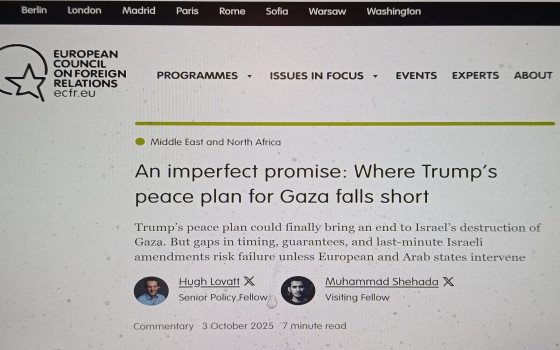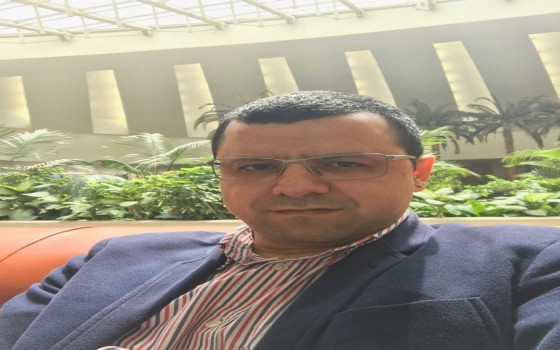
Report: Trump's peace plan may finally end Israel's destruction of Gaza. But gaps in timing, guarantees, and last-minute Israeli adjustments threaten to fail unless European and Arab countries intervene.

- Europe and Arabs
- Sunday , 12 October 2025 5:42 AM GMT
Brussels: Europe and the Arabs
Two years after the October 7 attacks, Israel and Hamas have agreed to the first phase of a ceasefire under Donald Trump's "peace plan" for Gaza. In a report we received and published by the Berlin-based European Council on Foreign Relations, analysts Hugh Lovatt and Mohammed Shehadeh point out that the plan represents a rare nod from the United States to the Palestinian right to self-determination, but it still lacks clarity on timing, guarantees, and governance. In "The World in 30 Minutes," Mark Leonard and Hugh Lovatt analyze what the agreement means for the future of Gaza and whether Europe can help transform this fragile truce into a lasting peace.
Thanks to European and Arab engagement, Trump's peace plan for Gaza gets the basics right for the most part: it rejects the forced displacement of Gaza's population and Israeli annexation of the territory, accepts a future role for the Palestinian Authority, and offers cautious support for Palestinian self-determination—all major shifts in US policy. In addition to a complete end to the war and the release of the hostages, the plan also includes a full, phased Israeli withdrawal from Gaza and the disarmament of Hamas and other Palestinian armed groups.
But it still faces the risk of failure. The Trump plan offers no clarity on timing or implementation, ignores the Israeli government's rejection of a two-state solution, and ignores the impact of Israeli sanctions on the Palestinian Authority and illegal settlements in the West Bank. Israeli Prime Minister Benjamin Netanyahu also obtained last-minute vaguely worded additions regarding the demilitarization of Gaza and reform of the Palestinian Authority, potentially allowing Israel to dictate the scope and pace of the plan's implementation once the hostages are released.
The Israeli amendments surprised Middle Eastern capitals. Egyptian authorities were outraged by the exclusion of the Palestinian Authority from the updated proposal. They pledged not to send a peacekeeping mission without a clear commitment to Palestinian sovereignty and the return of the Palestinian Authority to Gaza. Other Arab states, such as Saudi Arabia and Qatar, have echoed these conditions for joining any joint international force in Gaza. To succeed, Trump needs to expand the scope of his plan to gain not only regional support but also a full commitment from Hamas. However, at present, the absence of clear and enforceable guarantees—particularly regarding the scope and timetable of the Israeli withdrawal—threatens to entrench a fragmented, externally managed, and ultimately unsuccessful peace process. European countries should work closely with Arab and Muslim states to clearly define the required parameters and guarantees. Ultimately, European capitals must pressure to prevent a US and Israeli "take it or leave it" approach to Hamas, which is likely to undermine the entire process.
Post-Conflict Security
The Trump plan's post-conflict security framework for Gaza rests on three pillars: the gradual redeployment and eventual withdrawal of the Israeli Defense Forces; the disarmament of Hamas; and the deployment of an international stabilization force. These pillars are essential to the success of any ceasefire agreement and the possibility of a long-term settlement. However, these pillars require clearer terms of reference, as well as pressure on Hamas and Israel to adhere to their commitments. IDF Withdrawal and Hamas Disarmament
The original US plan required Hamas and other Palestinian factions to fully commit to “destroying and halting the construction of any offensive military infrastructure, including tunnels and weapons production facilities.” At Israel’s request, the final plan now states that “all military, terrorist, and offensive infrastructure, including tunnels and weapons production facilities, will be destroyed and will not be rebuilt.” This new formulation is more comprehensive and appears to imply the complete disarmament and disarmament of all Palestinian factions in Gaza. This is one of Israel’s long-standing goals, and perhaps an attempt to turn the plan into an objective that Hamas rejects.
Complete disarmament would not only amount to a total surrender for Hamas, but could also expose it to attacks by a range of enemies. Moreover, even if Hamas’s leadership accepts Israel’s demand, many of its fighters are likely to refuse to surrender and may defect to more militant groups less inclined to surrender (such as Islamic Jihad, the Popular Resistance Committees, and the Mujahideen Brigades). Persuading Hamas to engage in the dismantling process requires a greater Israeli commitment to withdraw from Gaza and engage in Israeli-Palestinian peace negotiations. But here too, Israel has framed the plan to serve its own interests. The revised proposal calls for a three-phase withdrawal. While the first two phases require the release of Israeli hostages and the deployment of Israeli security forces "in accordance with the parameters set forth in the Trump plan," Israel will maintain a "security buffer zone" encompassing more than 17% of Gaza's territory until the Strip is "completely secure from any renewed terrorist threat."
Reforming the Palestinian Authority
The return of the Palestinian Authority to Gaza and the launch of a new political process are contingent on its completion of a reform program linked to President Trump's 2020 peace plan, as well as a Saudi-French proposal. The latter calls for abolishing the "martyrs' and prisoners'" stipends system, reforming school textbooks, and committing to a ceasefire in Gaza within a year. So far, the Palestinian Authority has largely implemented the first two steps, and Abbas has pledged to hold legislative and presidential elections within a year of the ceasefire. However, it is not clear what this means for Hamas's participation (which will be an important and enabling local legislator in any electoral process) nor for Abbas, who is suffering from declining popularity. Once again, the American addition threatens to undermine this reform: the 2020 Trump plan also required the Palestinian Authority to waive its right to join “any international organization” without Israel’s consent and to refrain from taking action in bodies such as the International Criminal Court and the International Court of Justice. During his press conference, Netanyahu added the need for the Palestinian Authority to recognize Israel as a Jewish state. These American and Israeli conditions represent long-standing Palestinian red lines, and accepting them would further erode the PA’s already fragile legitimacy among Palestinians.
Where Does the Future Lie?
The plan is not without political obstacles. However, it identifies the need for a “credible path to Palestinian self-determination and statehood.” However, this fundamental principle directly collides with Israeli rejectionism: Netanyahu was quick to dismiss the withdrawal of Israeli forces from Gaza as “unrealistic” and has repeatedly rejected the existence of a Palestinian state—echoing virtually every Israeli political party. A credible peace process must begin with a ceasefire in Gaza, but it will not be sustainable without a fundamental shift in Israeli public and political positions and a reversal of Israeli settlement expansion in the West Bank. Securing political outcomes from Israel is also essential to sustaining the process of dismantling Hamas. All of this requires a concerted and sustained effort by European and Arab states to directly pressure Israel. They should also urge the United States to confront Netanyahu to secure the necessary Israeli commitments. Without this, the Trump plan could collapse before it is even implemented.












No Comments Found